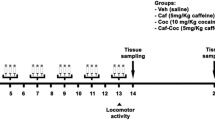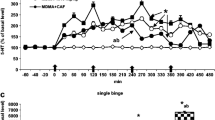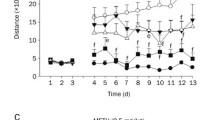Abstract
Methamphetamine (MAP: 1 and 2 mg/kg SC) and caffeine (CAF: 1, 3, 10 and 30 mg/kg SC) dose-dependently increased ambulation in mice. Repeated administration (5 times at 3 to 4-day intervals) of MAP, but not CAF, induced sensitization to its effect. Furthermore, the mice repeatedly receiving CAF showed no significant change in the sensitivity to MAP. Combined administration of MAP with CAF increased the effect. In the combinations of MAP (1 mg/kg) with CAF (3, 10 and 30 mg/kg), and MAP (2 mg/kg) with CAF (1 and 3 mg/kg), the effect was enhanced by the repeated administration. However, MAP sensitization was not modified by the combination with CAF in the repeated administration schedule, except in the combination of MAP (1 mg/kg) with CAF (30 mg/kg). The ambulation-increasing effects of MAP (1 mg/kg), CAF (10 mg/kg) and combination of MAP with CAF were almost equivalently inhibited by SCH 23390 (0.01 and 0.1 mg/kg SC) and YM-09151-2 (0.01 and 0.1 mg/kg SC). However, the inhibitory effects of apomorphine (0.05 mg/kg SC) andN 6-(L-phenylisopropyl)-adenosine (0.1 and 0.2 mg/kg SC) were stronger for CAF than for MAP and the combination, and those of α-methyl-p-tyrosine (200 mg/kg IP, 4 h before) and reserpine (1 mg/kg SC, 4 h before) were stronger for MAP and CAF alone than for the combination. The present results suggest that, although the combination of MAP and CAF enhances the ambulation-increasing effect through an interaction at dopaminergic system, CAF may not significantly modify the induction of MAP sensitization in mice.
Similar content being viewed by others
References
Cardinali DP (1980) Methylxanthine: possible mechanisms of action in brain. Trends Pharmacol Sci 1:405–407
Chou DT, Khan S, Forde J, Hirsh KR (1985) Caffeine tolerance: behavioral, electrophysiological and neurochemical evidence. Life Sci 36:2347–2358
Connell PH (1958) Amphetamine psychosis. Oxford University Press, New York
Deneau GA, Yanagita T, Seeverse MH (1969) Self-administration of psychoactive substances by the monkey-a measure of psychological dependence. Psychopharmacologia 16:30–48
Ellinwood EH, Sudilowsky A, Nelson LM (1973) Evolving behavior in the clinical and experimental (model) psychosis. Am J Psychiatry 130:1088–1092
Ferre S, Herrera-Marschtz M, Grabowska-Anden M, Ungerstedt U, Casas M, Anden N-E (1991a) Postsynaptic dopamine/adenosine interaction: I. Adenosine analogues inhibit dopamine D2-mediated behaviour in short-term reserpinized mice. Eur J Pharmacol 192:25–30
Ferre S, Herrera-Marschtz M, Grabowska-Anden M, Ungerstedt U, Casas M, Anden N-E (1991b) Postsynaptic dopamine/adenosine interaction: II. Postsynaptic dopamine agonism and adenosine antagonist of methylxanthine in short-term reserpinized mice. Eur J Pharmacol 191:31–37
Fischman MW (1987) Cocaine and amphetamines. In: Maltzer HY (ed) Psychopharmacology: the third generation of progress. Raven Press, New York, pp 1543–1553
Fredholm BB (1980) Are methylxanthine effects due to antagonism of endogenous adenosine? Trends Pharmacol Sci 1:129–132
Fujii W, Kuribara H, Tadokoro S (1989) Interaction between caffeine and methamphetamine by means of ambulatory activity in mice. Jpn J Psychopharmacol 11:225–231
Holtzman SG (1983) Complete, reversible, drug-specific tolerance to stimulation of locomotor activity by caffeine. Life Sci 33:779–787
Holtzman SG, Mante S, Minneman KP (1991) Role of adenosine receptors in caffeine tolerance. J Pharmacol Exp Ther 256:62–68
Iorio LC, Barnett A, Leitz FH, Houser VP, Korduba CA (1983) SCH 23390, a potential benzazepine antipsychotic with unique interaction on dopaminergic systems. J Pharmacol Exp Ther 226:462–468
Kuribara H, Hirabayashi M (1985) Reverse tolerance to psychotropic drugs. Jpn J Neuropsychopharmacol 7:421–439
Kuribara H, Tadokoro S (1989) Reverse tolerance to ambulation-increasing effects of methamphetamine and morphine in 6 mouse strains. Jpn J Pharmacol 49:197–203
Mailman RB, Shultz DL (1984) A selective D1 dopamine antagonist with D2 behavioral actions. Eur J Pharmacol 101:159–160
Mason ST (1984) Catecholamines and behavior. Cambridge University Press, Cambridge
McMillen BA (1983) CNS stimulants: two-distinct mechanisms of action for amphetamine-like drugs. Trends Pharmacol Sci 4:492–432
Robinson T, Becker J (1986) Enduring changes in brain and behavior produced by chronic amphetaminne administration: a review and evaluation of animal models of amphetamine psychosis. Brain Res Rev 11:157–198
Snyder SH (1975) Madness and the brain. McGraw-Hill Book, New York
Snyder SH, Katims JJ, Annau Z, Bruns RF, Daly JW (1981) Adenosine receptors and behavioral actions of methylxanthines. Proc Natl Acad Sci 78:3260–3264
Tadokoro S, Kuribara H (1986) Reverse tolerance to the ambulation-increasing effect of methamphetamine in mice as an animal model of amphetamine psychosis. Psychopharmacol Bull 22:757–762
Tadokoro S, Kuribara H (1990) Modification of behavioral effects of drugs after repeated administration; in particular, the reverse tolerance to amphetamines. Folia Pharmacol Japon 95:229–238
Terai M, Usuda S, Kuroiwa I, Noshiro O, Maeno H (1983) Selective binding of YM-09151-2, a new potent neuroleptic, to D2-dopamine receptors. Jpn J Pharmacol 33:749–755
Yanagita T (1992) Overview of the progress in drug dependence studies-mainly focussing on psychic dependence. Folia Pharmacol Japon 100:97–107
Author information
Authors and Affiliations
Rights and permissions
About this article
Cite this article
Kuribara, H. Caffeine enhances the stimulant effect of methamphetamine, but may not affect induction of methamphetamine sensitization of ambulation in mice. Psychopharmacology 116, 125–129 (1994). https://doi.org/10.1007/BF02245053
Received:
Revised:
Issue Date:
DOI: https://doi.org/10.1007/BF02245053




